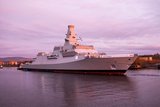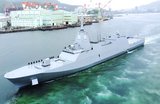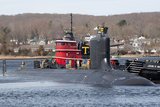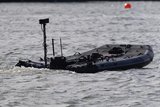German Type 424 SIGINT vessel moves forward with keel laying
An author's impression of how the Type 424 vessels will look in service. (Image: German MoD)
The first of Germany’s new Type 424 SIGINT vessels has had its keel laid at the Wolgast Peene shipyard in Mecklenburg-Vorpommern, Germany.
The three Type 424 vessels are scheduled to replace the ageing Type 423 Oste-class vessels, the Oste, Oker, and Alster, as they are commissioned, at a programme cost of €3.3 billion (US$3.5 billion).
Commissioning of the new vessels is expected between 2029 and 2031, along with the build and operation of a training and reference facility for the vessels. That training centre is scheduled to be completed in 2027, giving users time to get up to speed in the operation of the new vessels before they are brought into service.
Related Articles
Steel cutting begins on German Type 424 SIGINT ships
NATO to strengthen its Baltic Sea presence after new cable cutting incident
Latest undersea cable damage incident investigated in Baltic Sea
NVL was contracted to build the three new SIGINT vessels in 2023, and the steel-cutting ceremony for the first vessel was held in late November 2024.
Among those at the keel-laying ceremony was the Inspector of the Cyber and Information Space, Vice Admiral Thomas Daum, who emphasised the strategic importance of the future units for Germany's maritime security architecture.
“Our fleet service boats in particular, driven by the German Navy and operated in reconnaissance by soldiers of the Cyber and Information Space Service, are a highly effective, indispensable strategic reconnaissance tool for war-ready armed forces. I am therefore delighted about the keel-laying of the first fleet service boat of class 424,” said the Daum.
According to the Bundeswehr, the new vessels will be equipped with advanced surface and underwater reconnaissance components as well as technology that allows them command and control capabilities and the likes of low-noise propulsion systems.
The Type 424 service boats will be around 130 meters in length and will serve as reconnaissance platforms for sea-based intelligence gathering.
Particularly in light of recent tensions in the Baltic Sea, they are expected to play a significant role in delivering marine intelligence in that region.
Related Programmes in Defence Insight
More from Naval Warfare
-
![Hanwha wins Australian government approval to increase its stake in Austal]()
Hanwha wins Australian government approval to increase its stake in Austal
The contract would mean the two shipbuilders can collaborate strategically and enhance shipbuilding capabilities in Western Australia.
-
![UK to join US Navy’s Virginia-class submarine assembly effort to speed up construction]()
UK to join US Navy’s Virginia-class submarine assembly effort to speed up construction
The expansion of the Virginia-class submarine construction to UK shores could accelerate the project as US shipbuilders continue to fall short of delivery goals.
-
![US Navy seeks new sensors for the CH-53K King Stallion heavy-lift helicopter]()
US Navy seeks new sensors for the CH-53K King Stallion heavy-lift helicopter
The US Navy intends to publish a draft request for proposals in Q2 2026 and conduct an open competition for the supply of new electro-optical and infrared capabilities for the CH-53K heavy-lift helicopter.
-
![NATO naval exercises map out future USV requirements but raise questions on acquisition]()
NATO naval exercises map out future USV requirements but raise questions on acquisition
Uncrewed surface vessels have shifted from a desirable capability to a critical one for navies. But should these systems be bought outright, rented as a service or rapidly built using commercial off-the-shelf components?























